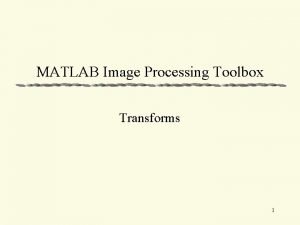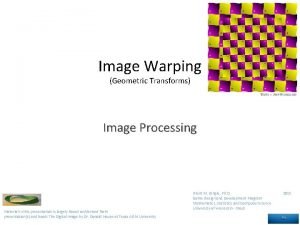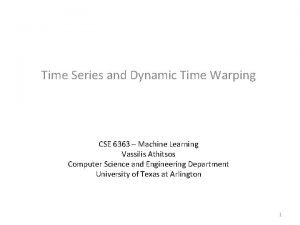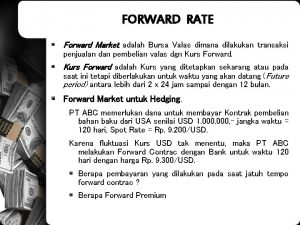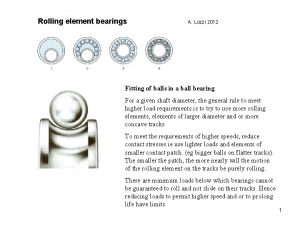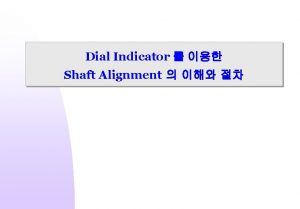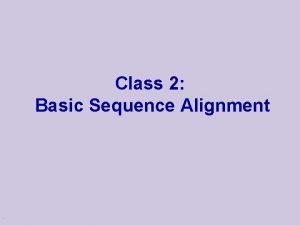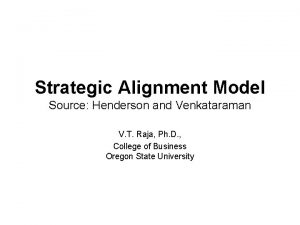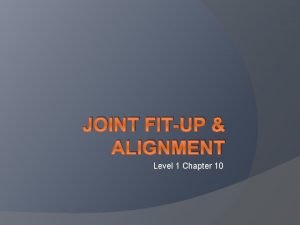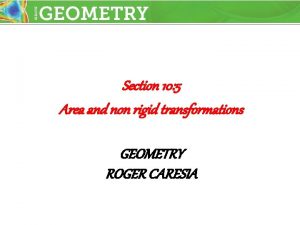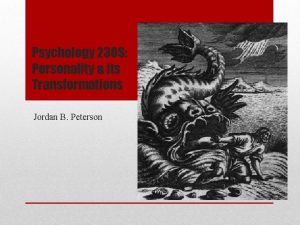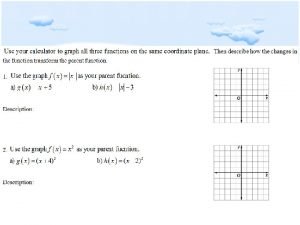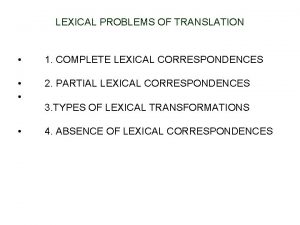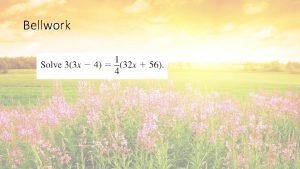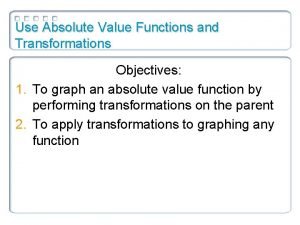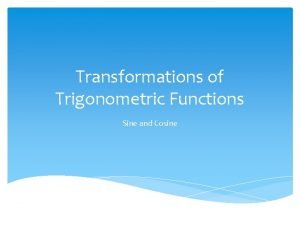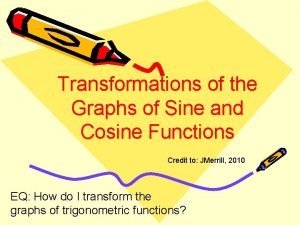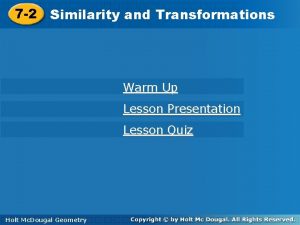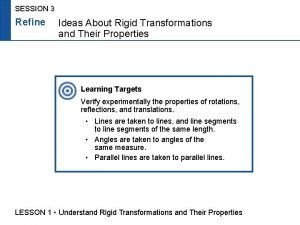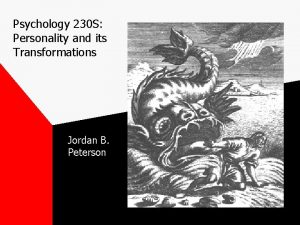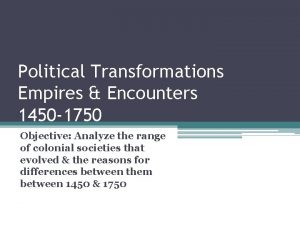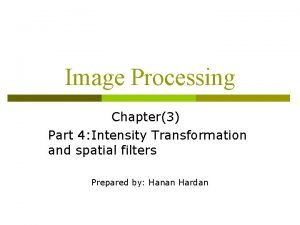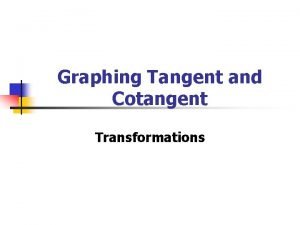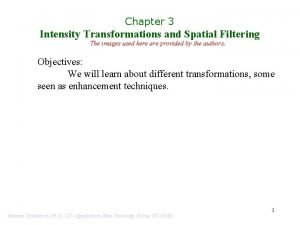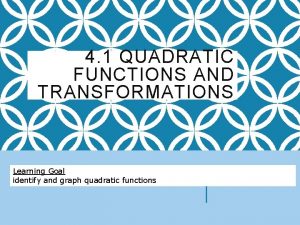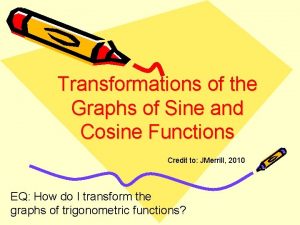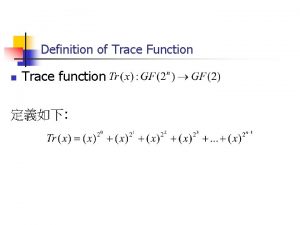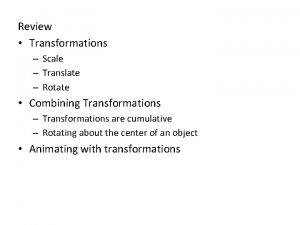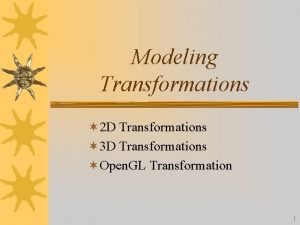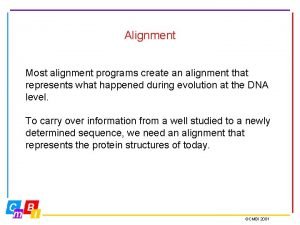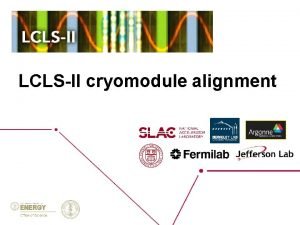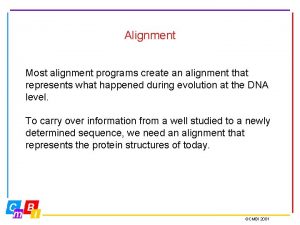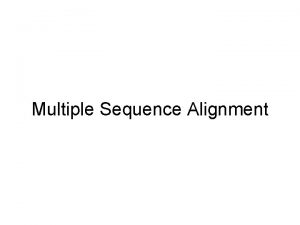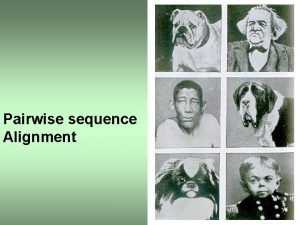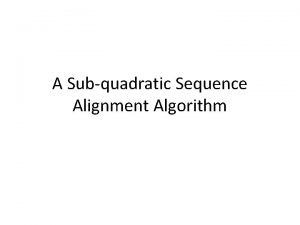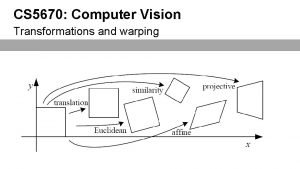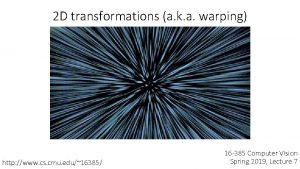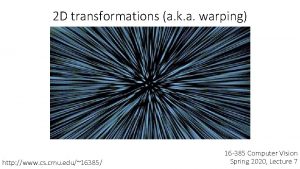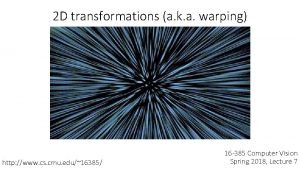Today Alignment warping 2 d transformations Forward and









































































- Slides: 73


Today • Alignment & warping – 2 d transformations – Forward and inverse image warping – Constructing mosaics • Homographies • Robust fitting with RANSAC

Main questions T T Warping: Given a source image and a transformation, what does the transformed output look like? Alignment: Given two images with corresponding features, what is the transformation between them?

Motivation: Mosaics • Getting the whole picture – Consumer camera: 50˚ x 35˚ Slide from Brown & Lowe 2003

Motivation: Mosaics • Getting the whole picture – Consumer camera: 50˚ x 35˚ – Human Vision: 176˚ x 135˚ Slide from Brown & Lowe 2003

Motivation: Mosaics • Getting the whole picture – Consumer camera: 50˚ x 35˚ – Human Vision: 176˚ x 135˚ • Panoramic Mosaic = up to 360 x 180° Slide from Brown & Lowe 2003

Warping problem • Given a set of points and a transformation, generate the warped image T(x, y) y’ y x f(x, y) x’ g(x’, y’) Figure Alyosha Efros

Parametric (global) warping Examples of parametric warps: aspect rotation translation affine perspective Source: Alyosha Efros

Parametric (global) warping T p = (x, y) p’ = (x’, y’) Transformation T is a coordinate-changing machine: p’ = T(p) What does it mean that T is global? • Is the same for any point p • can be described by just a few numbers (parameters) Let’s represent T as a matrix: p’ = Mp Source: Alyosha Efros

Scaling a coordinate means multiplying each of its components by a scalar Uniform scaling means this scalar is the same for all components: 2 Source: Alyosha Efros

Scaling Non-uniform scaling: different scalars per component: X 2, Y 0. 5 Source: Alyosha Efros

Scaling operation: Or, in matrix form: scaling matrix S Source: Alyosha Efros

What transformations can be represented with a 2 x 2 matrix? 2 D Scaling? 2 D Rotate around (0, 0)? 2 D Shear? Source: Alyosha Efros

What transformations can be represented with a 2 x 2 matrix? 2 D Mirror about Y axis? 2 D Mirror over (0, 0)? 2 D Translation? NO! Source: Alyosha Efros

2 D Linear Transformations Only linear 2 D transformations can be represented with a 2 x 2 matrix. Linear transformations are combinations of … • Scale, • Rotation, • Shear, and • Mirror Source: Alyosha Efros

Homogeneous Coordinates Q: How can we represent translation as a 3 x 3 matrix using homogeneous coordinates? Source: Alyosha Efros

Homogeneous Coordinates Q: How can we represent translation as a 3 x 3 matrix using homogeneous coordinates? A: Using the rightmost column: Source: Alyosha Efros

Translation Homogeneous Coordinates tx = 2 ty = 1 Source: Alyosha Efros

Basic 2 D Transformations Basic 2 D transformations as 3 x 3 matrices Translate Scale Rotate Shear Source: Alyosha Efros

2 D Affine Transformations Affine transformations are combinations of … • Linear transformations, and • Translations Parallel lines remain parallel

Projective Transformations Projective transformations: • Affine transformations, and • Projective warps Parallel lines do not necessarily remain parallel

Recap Linear Transformation Scale, Rotation, Shear, and Mirror Affine Transformation Linear Transformation and Translation Parallel lines remain parallel Projective Transformation Affine transformations, and Projective warps Parallel lines do not necessarily remain parallel

Today • Alignment & warping – 2 d transformations – Forward and inverse image warping – Constructing mosaics • Homographies • Robust fitting with RANSAC

Image warping T(x, y) y’ y x f(x, y) x’ g(x’, y’) Given a coordinate transform and a source image f(x, y), how do we compute a transformed image g(x’, y’) = f(T(x, y))? Slide from Alyosha Efros, CMU

Forward warping T(x, y) y’ y x f(x, y) x’ g(x’, y’) Send each pixel f(x, y) to its corresponding location (x’, y’) = T(x, y) in the second image Q: what if pixel lands “between” two pixels? Slide from Alyosha Efros, CMU

Forward warping T(x, y) y’ y x f(x, y) x’ g(x’, y’) Send each pixel f(x, y) to its corresponding location (x’, y’) = T(x, y) in the second image Q: what if pixel lands “between” two pixels? A: distribute color among neighboring pixels (x’, y’) – Known as “splatting” Slide from Alyosha Efros, CMU

Inverse warping T-1(x, y) y’ y x f(x, y) x’ g(x’, y’) Get each pixel g(x’, y’) from its corresponding location (x, y) = T-1(x’, y’) in the first image Q: what if pixel comes from “between” two pixels? Slide from Alyosha Efros, CMU

Inverse warping T-1(x, y) y’ y x f(x, y) x’ g(x’, y’) Get each pixel g(x’, y’) from its corresponding location (x, y) = T-1(x’, y’) in the first image Q: what if pixel comes from “between” two pixels? A: Interpolate color value from neighbors – nearest neighbor, bilinear… Slide from Alyosha Efros, CMU >> help interp 2

Bilinear interpolation Sampling at f(x, y): Slide from Alyosha Efros, CMU

Alignment problem • We have previously considered how to fit a model to image evidence – e. g. , a line to edge points, or a snake to a deforming contour • In alignment, we will fit the parameters of some transformation according to a set of matching feature pairs (“correspondences”). ' xi xi T

Fitting an affine transformation Affine model approximates perspective projection of planar objects. Figures from David Lowe, ICCV 1999

Fitting an affine transformation • Assuming we know the correspondences, how do we get the transformation?

An aside: Least Squares Example Say we have a set of data points (X 1, X 1’), (X 2, X 2’), (X 3, X 3’), etc. (e. g. person’s height vs. weight) We want a nice compact formula (a line) to predict X’s from Xs: Xa + b = X’ We want to find a and b How many (X, X’) pairs do we need? Ax=b What if the data is noisy? overconstrained Source: Alyosha Efros

An aside: Least Squares Example Geometric meaning of LSQ: The columns of A define an n-dimensional subspace in R^m We seek the point Ax, in that subspace, that is closest to b. Q: How do we compute the inverse?

SVD to the rescue Every matrix A (mxn) can be decomposed into: A=USV’ Where: U is mxm, S is mxn and V is nxn. Then pinv(A’A) can be solved as follows: [U, S, V] = svd(A’A); i. S = S; i. S(i. S>1 e-6) = 1. /i. S(i. S>1 e-6); pinv. ATA = V*i. S*U’; Proof: U*S*V * V’*i. S*U’ = U*S*I*i. S*U’ = U*I*U’ = I (because U, V are orthonormal)

Geometric meaning of SVD Let A = USV’ Then V is coordinate system of input space and U coordinate system of output space. S is the scaling matrix. Specifically, V’ maps from input space coordinate system to canonical Coordinate system. S scales the coordinates and U maps them to the new Coordinate system. That’s how we should understand: x=pinv(A’A)A’b. Essentially, A’b projects b to the coloumns of A. However, we need to normalize Them and we achieve this by pinv(A’A), which in our case simply scales the Coordinates (because for normal equations A’A then A’A=USU’)

Fitting an affine transformation • Assuming we know the correspondences, how do we get the transformation?

Fitting an affine transformation • How many matches (correspondence pairs) do we need to solve for the transformation parameters? • Once we have solved for the parameters, how do we compute the coordinates of the corresponding point for ?

What are the correspondences? ? • Compare content in local patches, find best matches. e. g. , simplest approach: scan with template, and compute SSD or correlation between list of pixel intensities in the patch • Later in the course: how to select regions according to the geometric changes, and more robust descriptors.

Panoramas. . . image from S. Seitz Obtain a wider angle view by combining multiple images.

How to stitch together a panorama? • Basic Procedure – Take a sequence of images from the same position • Rotate the camera about its optical center – Compute transformation between second image and first – Transform the second image to overlap with the first – Blend the two together to create a mosaic – (If there are more images, repeat) • …but wait, why should this work at all? – What about the 3 D geometry of the scene? – Why aren’t we using it? Source: Steve Seitz

Homography How to relate two images from the same camera center? – how to map a pixel from PP 1 to PP 2? Think of it as a 2 D image warp from one image to another. A projective transform is a mapping between any two PPs with the same center of projection • rectangle should map to arbitrary quadrilateral • parallel lines aren’t • but must preserve straight lines PP 2 called Homography p’ H p PP 1 Source: Alyosha Efros

Homography To apply a given homography H • Compute p’ = Hp (regular matrix multiply) • Convert p’ from homogeneous to image coordinates p’ H p

Homography … … To compute the homography given pairs of corresponding points in the images, we need to set up an equation where the parameters of H are the unknowns…

SVD to the rescue again We wish to solve Ax=0. Then Let A=USV’ and take x=V( : , end ) be the last eigenvector corresponding to the smallest eigenvalue of AAT. Then: Ax = U*S*V’*V(: , end) Lets look at V’*V(: , end): V(: , i)’*V(: , end) = 0 for every i<end. V(: , end)’*V(: , end)=1 because V is orthonormal. This is multiplied by S( end, end ) which is the smallest of singular value of A.

Recap: How to stitch together a panorama? • Basic Procedure – Take a sequence of images from the same position • Rotate the camera about its optical center – Compute transformation between second image and first – Transform the second image to overlap with the first – Blend the two together to create a mosaic – (If there are more images, repeat) Source: Steve Seitz

Today • Alignment & warping – 2 d transformations – Forward and inverse image warping – Constructing mosaics • Homographies • Robust fitting with RANSAC

Outliers • Outliers can hurt the quality of our parameter estimates, e. g. , – an erroneous pair of matching points from two images – an edge point that is noise, or doesn’t belong to the line we are fitting.

Example: least squares line fitting • Assuming all the points that belong to a particular line are known

Outliers affect least squares fit

Outliers affect least squares fit

RANSAC • RANdom Sample Consensus • Approach: we want to avoid the impact of outliers, so let’s look for “inliers”, and use those only. • Intuition: if an outlier is chosen to compute the current fit, then the resulting line won’t have much support from rest of the points.

RANSAC – The Math Assume: w = number of inliers/number of points in data Desired probability of success: p – probability that RANSAC selected only inliers in one of the iterations Given: n – The minimum number of sample points required to fit a model t – A threshold value for determining if point fits model d – The minimum number of points to support a model Find k k – The number of iteration needed w^n is the probability that all n points are inliers (1 -w^n) is the probability that at least one point is an outlier. (1 -w^n)^k – probability of failure in k iterations 1 -p = (1 -w^n)^k Taking the log on both sides we have: k = log(1 -p)/log(1 -w^n)

RANSAC – A graph

RANSAC • RANSAC loop (for k iterations): 1. Randomly select a seed group of n points on which to base transformation estimate (e. g. , a group of matches) 2. Compute transformation from seed group 3. Find inliers to this transformation (all points with error smaller than t) 4. If the number of inliers is sufficiently large (i. e. greater than d), re-compute least-squares estimate of transformation on all of the inliers • Keep the transformation with the largest number of inliers

RANSAC Line Fitting Example Task: Estimate best line Slide credit: Jinxiang Chai, CMU

RANSAC Line Fitting Example Sample two points

RANSAC Line Fitting Example Fit Line

RANSAC Line Fitting Example Total number of points within a threshold of line.

RANSAC Line Fitting Example Repeat, until get a good result

RANSAC Line Fitting Example Repeat, until get a good result

RANSAC Line Fitting Example Repeat, until get a good result

RANSAC example: Translation Putative matches Source: Rick Szeliski

RANSAC example: Translation Select one match, count inliers

RANSAC example: Translation Select one match, count inliers

RANSAC example: Translation Find “average” translation vector

Feature-based alignment outline Source: L. Lazebnik

Feature-based alignment outline • Extract features Source: L. Lazebnik

Feature-based alignment outline • • Extract features Compute putative matches Source: L. Lazebnik

Feature-based alignment outline • • • Extract features Compute putative matches Loop: • Hypothesize transformation T (small group of putative matches that are related by T) Source: L. Lazebnik

Feature-based alignment outline • • • Extract features Compute putative matches Loop: • • Hypothesize transformation T (small group of putative matches that are related by T) Verify transformation (search for other matches consistent with T) Source: L. Lazebnik

Feature-based alignment outline • • • Extract features Compute putative matches Loop: • • Hypothesize transformation T (small group of putative matches that are related by T) Verify transformation (search for other matches consistent with T) Source: L. Lazebnik

Today • Alignment & warping – 2 d transformations – Forward and inverse image warping – Constructing mosaics • Homographies • Robust fitting with RANSAC
 Semi global alignment
Semi global alignment Global alignment
Global alignment Pam1250
Pam1250 Global alignment vs local alignment
Global alignment vs local alignment Global vs local alignment
Global vs local alignment Morphing and warping in multimedia
Morphing and warping in multimedia Warping in computer graphics
Warping in computer graphics Animation warping
Animation warping Eamonn keogh
Eamonn keogh Image warping matlab
Image warping matlab Local warping
Local warping Affine image warping
Affine image warping Eamonn keogh
Eamonn keogh What does this sign mean
What does this sign mean Introduction to dsp
Introduction to dsp Dynamic time warping
Dynamic time warping Currency forward market
Currency forward market Forward market adalah
Forward market adalah For todays meeting
For todays meeting In todays lesson
In todays lesson Proposal kickoff meeting agenda
Proposal kickoff meeting agenda Characteristic of fingerprint
Characteristic of fingerprint Today's lesson or today lesson
Today's lesson or today lesson Today's lesson or today lesson
Today's lesson or today lesson Axial and radial alignment formula
Axial and radial alignment formula Difference between local and global alignment
Difference between local and global alignment An idealized image that we have developed over time
An idealized image that we have developed over time Image alignment
Image alignment Jayakar committee
Jayakar committee Enterprise architecture alignment
Enterprise architecture alignment Dial gauge shaft alignment
Dial gauge shaft alignment Difference between local and global alignment
Difference between local and global alignment Automotive steering, suspension and alignment
Automotive steering, suspension and alignment Effective length factor k
Effective length factor k Henderson venkatraman strategic alignment model
Henderson venkatraman strategic alignment model Joint fit up and alignment
Joint fit up and alignment Self ideal y self real
Self ideal y self real Railway alignment design and geometry
Railway alignment design and geometry Building equity and alignment
Building equity and alignment Rigid vs non rigid transformations
Rigid vs non rigid transformations Personality and its transformations
Personality and its transformations What is a parent function
What is a parent function Lexical problems of translation
Lexical problems of translation Parent functions transformations
Parent functions transformations Transformations of linear and absolute value functions
Transformations of linear and absolute value functions Transformations of sine and cosine functions
Transformations of sine and cosine functions What is amplitude in trigonometry
What is amplitude in trigonometry 7-2 similarity transformations
7-2 similarity transformations 2-7 parent functions and transformations
2-7 parent functions and transformations Transformations and congruence
Transformations and congruence Energy conservation and transformation
Energy conservation and transformation Energy transformations and conservation
Energy transformations and conservation 100 examples of energy transformation
100 examples of energy transformation Economic transformations commerce and consequence
Economic transformations commerce and consequence 4-1 congruence
4-1 congruence Chapter 15 cultural transformations religion and science
Chapter 15 cultural transformations religion and science The study of energy and its transformations.
The study of energy and its transformations. Lesson 2 session 3
Lesson 2 session 3 Introduction to personality and its transformations
Introduction to personality and its transformations Political transformations empires and encounters
Political transformations empires and encounters Chapter 5 political transformations empires and encounters
Chapter 5 political transformations empires and encounters Doterra taiwan
Doterra taiwan Intensity transformations and spatial filtering
Intensity transformations and spatial filtering Intensity transformations and spatial filtering
Intensity transformations and spatial filtering Intensity transformation and spatial filtering
Intensity transformation and spatial filtering Graphing tangent and cotangent worksheet answers
Graphing tangent and cotangent worksheet answers Congruent segments
Congruent segments Cultural transformations religion and science
Cultural transformations religion and science Intensity transformations and spatial filtering
Intensity transformations and spatial filtering 4-1 quadratic functions and transformations
4-1 quadratic functions and transformations Transformations of sine and cosine functions
Transformations of sine and cosine functions Hadamard basis
Hadamard basis Parent functions
Parent functions Virtual labs energy transformation
Virtual labs energy transformation









